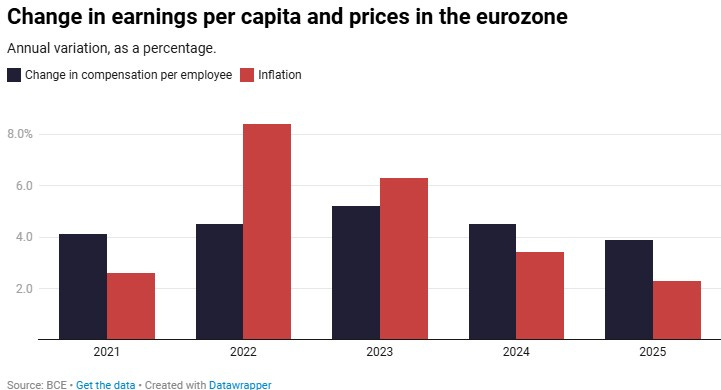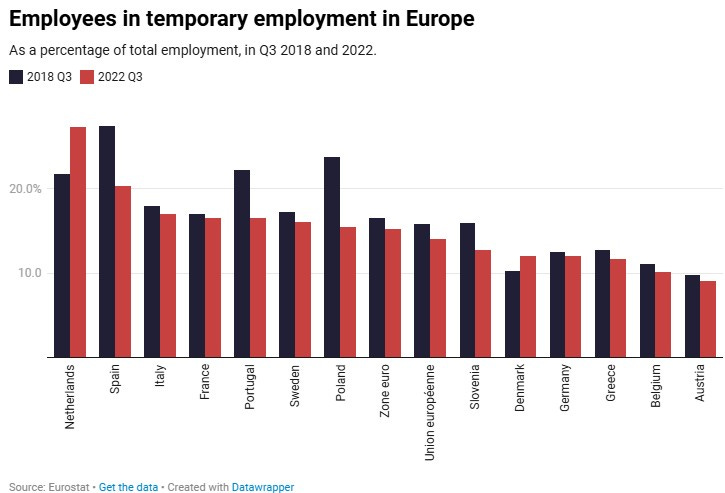The “Great Resignation” in Europe: what really happened and what is next?
Exploring the shift in workforce trends and how businesses can prepare for the future
The so-called “Great Resignation” may have taken many by surprise, but the reality in Europe was much more nuanced than the mass exodus some expected. Coined in the United States, the term refers to the widespread wave of voluntary resignations that began in 2021, as millions of employees left their jobs in search of better pay, improved work–life balance, or more meaningful work. While headlines suggested a global phenomenon, the European labour market told a more complex story. As employees across the continent redefined what they sought from their work, this shift altered the workforce in ways no one could have predicted. But has the storm passed, or is the labour market on the verge of yet another upheaval? The journey of understanding this transformation and what it means for the future of work starts here.
What you will learn in this article:
The causes of the “Great Resignation”: discover the key factors driving the shift in the labour market, including burnout, work-life balance struggles, and lack of career growth
Impact across Europe: see how resignation rates soared in countries such as the UK, France, and Germany, reshaping the workforce
Economic consequences: learn how businesses faced labour shortages, increased recruitment costs, and productivity declines due to disengagement
The shift to stability: find out how economic uncertainty and improved work-life balance are leading to the "Big Stay"
Long-term changes: explore lasting shifts in work models, employee expectations, and retention strategies
What is next?: understand the potential for the “Great Resignation’s” return and what businesses need to do to adapt
What sparked the great resignation? Unpacking the causes
The term "Great Resignation" was first introduced by Anthony Klotz in 2021, when he predicted that the pandemic would lead workers to reassess their priorities, particularly in relation to their jobs and personal lives. His forecast turned out to be accurate, as several key factors contributed to a shift in the labour market. The most immediate of these was burnout, a condition that had been growing in prominence long before the pandemic but was exacerbated by the pressures of remote work, isolation, and health concerns. By 2022, reports indicated that nearly 50% of workers worldwide were suffering from burnout, with some countries experiencing even higher levels—Poland (70%) and Romania (67%) being two notable examples. This overwhelming sense of exhaustion, emotional depletion, and diminished motivation left many employees feeling disengaged, prompting a revaluation of their work lives.
This sense of burnout was closely tied to broader issues around work-life balance, which became a significant consideration for many. The pandemic blurred the lines between home and work, leading employees to question whether the sacrifices they were making for their jobs were worth the toll on their personal lives. According to Gallup for 59% of workers, achieving a better balance became the top reason for seeking new opportunities. As boundaries became less defined, many workers reassessed their priorities and began seeking roles that offered more flexibility and respect for personal time.
Alongside burnout and work-life balance, career growth (or the lack thereof) also played a major role in the “Great Resignation”. According to Pew Research Center 63% of workers—left their jobs in pursuit of greater career development opportunities and salaries. A lack of progression in their roles, compounded by feelings of stagnation and a lack of recognition, drove many to seek out organisations where they felt their professional growth would be better supported.
An additional layer of complexity came from the engagement crisis. Gallup’s 2022 report found that only 14% of European workers were truly engaged in their work, compared to 33% in North America. This stark contrast highlighted the disconnect between employees and their organisations, leading to what became known as "quiet quitting"—the act of doing only what a job strictly requires, without going above and beyond. This phenomenon was a silent but significant response to feelings of disengagement, manifesting in reduced productivity and enthusiasm, further propelling the broader trend of workforce dissatisfaction.
The European shake-up: How the great resignation swept the continent
At first, Europe seemed to be less susceptible to the “Great Resignation”, largely due to stronger worker protections and more comprehensive social safety nets than those found in the US. However, by 2022, resignation rates began to rise sharply across the continent, indicating that even with these advantages, the shift was not to be underestimated.
In the Netherlands, for example, 1.9 million workers changed jobs in early 2022, an increase of 400,000 from the previous year. The UK saw 442,000 resignations in Q2 of 2022, marking the highest number in over a decade. In Germany, 40% of employees expressed a desire to leave their jobs if they could afford it, indicating an underlying restlessness. In France, the early 2022 period saw an average of 520,000 resignations per quarter. Across the European Union, job vacancy rates surged to 2.9%, with Austria leading the pack at a unusually high 5%.
These statistics show that while Europe had its own unique conditions, the “Great Resignation” was nonetheless a reality, and the movement gained significant momentum, reshaping employment landscapes across the continent.
The ripple effect: How the great resignation reshaped Europe's economy
The surge in resignations had profound implications for businesses and the wider economy. One of the most significant consequences was the labour shortage, which particularly impacted countries such as Germany, where the healthcare and hospitality sectors faced an urgent need for skilled workers. The nation required 400,000 workers annually to meet demand, further exacerbating the strain on the labour market.
Slovenia reported shortages across 99 different professions, a staggering number that highlighted the scale of the problem. As businesses scrambled to fill roles, recruitment costs spiked. According to Gallup, the cost of replacing an employee could range from 50% to 200% of their annual salary, depending on the role and sector.
At the same time, quiet quitting became an increasing concern for employers. This subtle form of resignation, where employees reduced their effort without leaving the company, led to a marked decline in workplace productivity. Businesses found themselves grappling with not just staffing shortages but also reduced efficiency, making it harder to meet their targets and objectives.
From exodus to stability: The rise of the “Big Stay”
As 2024 approached, a new trend began to emerge—the Big Stay. After a period of mass resignations, fewer employees were choosing to leave their roles. This shift was driven by several interconnected factors. Economic uncertainty was a major driver, with companies tightening their belts, leading to fewer job opportunities. As wages rose—4.5% in 2022 and 5.2% in 2023—inflation also took its toll, eroding real earnings. In 2022, inflation stood at 8.4%, dropping to 6.3% in 2023. This prompted many workers to reconsider job-hopping in favour of financial stability.
However, not all reasons for the shift to the Big Stay were negative. There were improvements in work-life balance, particularly as hybrid and flexible work models became more widespread. Employees found that they could achieve a healthier balance between their personal and professional lives, making them less likely to leave. Concerns over job security also played a role; workers increasingly prioritised stability over the uncertainty of switching jobs, especially in a fluctuating economy.
Workplace revolution: How the great resignation changed the labour market forever
The “Great Resignation” left a lasting imprint on the labour market, with several significant transformations that continue to shape the workplace today. Hybrid work adoption surged, with 12.7% of employees working remotely and 28.2% following a hybrid model by 2023. These shifts were not merely a passing phase; they represented a fundamental change in how people view work, and how businesses approach flexibility.
Furthermore, the “Great Resignation” amplified employee bargaining power. The surge in resignations led employers to re-evaluate their approach to compensation, benefits, and employee development. Companies began prioritising mental health support, offering better benefits, and expanding career growth opportunities to retain talent. This led to a broader shift in employment structures as well, with permanent contracts becoming more common, changing from 15.9% in 2018 to 14.1% in 2022. Meanwhile, part-time work saw a decline, reflecting a preference for more stable, long-term roles.
What we learned: Key insights from the great resignation phenomenon
By 2023, the workforce had adapted to new ways of working. Hybrid models became more common, and a significant number of employees began to value workplace well-being and skills development. Companies, recognising the importance of these factors, started to offer better benefits, aiming to keep talent from seeking alternative opportunities.
Despite these positive changes, the rapid wage increases of 2021-2022, which had initially fuelled the job-hopping trend, began to slow. Employees, while still valuing compensation, started to place greater emphasis on stability and long-term career development, shifting their focus away from constant job changes.
Is it coming back? The potential return of the great resignation
Although the Big Stay has largely dominated recent trends, signs suggest a potential resurgence of resignations. PwC’s 2024 survey found that 28% of workers plan to quit, compared to or increasing from 19% in 2022. Similarly, a Microsoft-LinkedIn study revealed that 46% of global employees are considering leaving their jobs in the next year. This shift may be due, in part, to generational demands—Millennials and Gen Z workers are pushing for better flexibility, pay equity, and more opportunities for career development.
There is also an undercurrent of concern regarding automation. While 72% of workers believe AI could improve work quality, many still worry about job security as automation continues to rise and reshape industries. These factors combined suggest that while the Big Stay is still in play, it may be a temporary phase.
Looking ahead: Is the future of work set for another shake-up?
The “Great Resignation” in Europe was undoubtedly real, but its shape diverged significantly from the US experience. In Europe, what seemed like an exodus was more of a "Great Turnover." Employees were not abandoning the workforce; they were redefining what work should offer—better flexibility, mental health support, and clearer opportunities for career growth.
As the labour market continues to evolve, businesses will need to be not just reactive but proactive in shaping the future of work. The question is: Are we truly moving past the “Great Resignation”, or is this the calm before a new wave of disruption? Will companies rise to the challenge of redefining work, or will they find themselves caught in the next phase of employee re-evaluation?
Key takeaways:
Burnout and work-life balance: Burnout, intensified by the pandemic, and the growing struggle to achieve work-life balance were pivotal drivers behind the 'Great Resignation,' with many workers seeking more fulfilling job conditions
Quiet quitting: A significant form of disengagement, quiet quitting revealed widespread dissatisfaction, especially in Europe, where engagement levels were particularly low
Impact across Europe: Despite stronger worker protections in Europe, resignation rates spiked, with countries such as the UK and France seeing unprecedented numbers of workers leaving their jobs
Labour shortages and costs: The wave of resignations led to severe labour shortages, particularly in healthcare and hospitality sectors, escalating recruitment costs and placing pressure on businesses
The shift to the big stay: Rising economic uncertainty, coupled with the widespread adoption of hybrid work models, prompted many workers to favour job stability over frequent job changes, shifting the focus from the “Great Resignation” to the "Big Stay"
Long-term shifts: The “Great Resignation” catalysed lasting changes in the labour market, driving increased adoption of hybrid work, empowering employees with greater bargaining power, and urging businesses to rethink retention strategies
Looking ahead: As demand for flexibility and career growth continues, businesses must remain agile and responsive to employees’ expectations to avoid a potential resurgence of the resignation trend
Coming next:
Decades ago, futurists promised us a working world of leisure, creativity, and digital liberation. But as their bold forecasts collide with today’s messy realities, a new question arises: what do our past visions say about the revolutions unfolding now? Are we any better at imagining the future—or just repeating the same illusions in smarter packaging? Join us next time as we explore what looking back tells us about what comes next.
Sources used to write this text:








